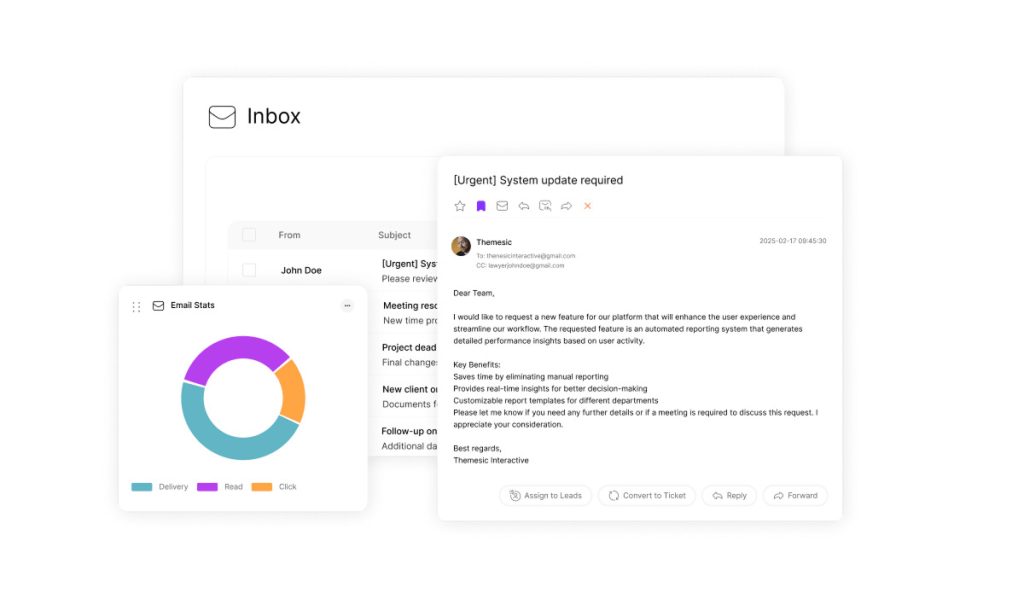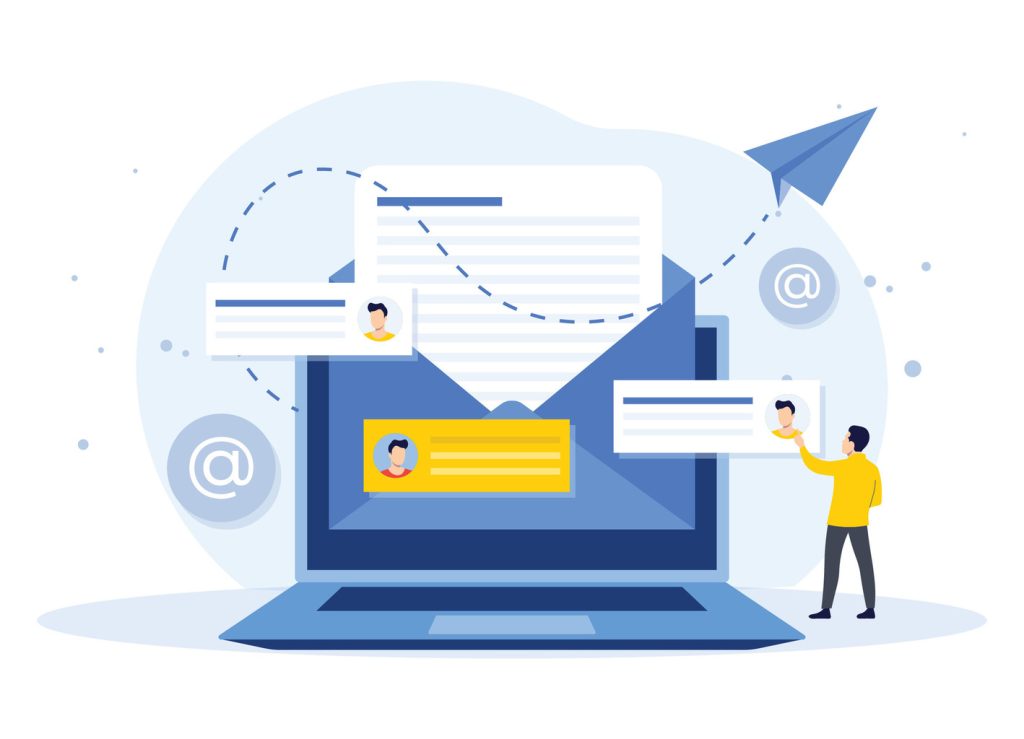Generate Support Tickets From Emails: A Step-by-Step Guide

Modern businesses face an operational paradox. While email remains the primary channel for customer inquiries, traditional inbox management often creates bottlenecks. ClearCRM helps teams avoid missed deadlines, duplicated efforts, and frustrated clients by streamlining the process of sorting through hundreds of daily messages.
Structured ticketing systems resolve this challenge by converting unstructured communication into trackable tasks. These platforms automatically generate numbered cases from incoming messages, assigning clear ownership and deadlines. Service teams gain real-time visibility into workloads, while customers receive consistent updates through automated status alerts.
Additionally, data shows organizations using email-to-ticket conversion achieve 40% faster response times and 25% higher first-contact resolution rates. Finally, categorization features ensure urgent requests receive immediate attention, while historical data helps identify recurring issues. Also, this approach transforms reactive firefighting into proactive service delivery.
Key Takeaways
- Automated ticket creation reduces manual sorting by 60%
- Centralized tracking improves team accountability
- Priority tagging ensures critical issues get addressed first
- Performance analytics reveal service gaps
- Implementation requires phased tool integration
This guide details how to configure intelligent routing rules, set escalation protocols, and integrate with existing CRM platforms. Decision-makers will learn to balance automation with human oversight, creating seamless transitions between email threads and resolution workflows.
Introduction to Email Ticketing Systems

In addition, the shift from chaotic email threads to structured workflows marks a new era in customer service efficiency. As a result, email ticketing software transforms disorganized communication streams into actionable tasks, creating order where manual processes often fail.
These platforms automatically convert messages into numbered cases with detailed tracking histories. Features include:
- Automatic categorization by urgency or topic
- Real-time assignment notifications for team members
- Unified dashboards showing resolution progress
Businesses maintain existing email addresses while gaining enterprise-grade organizational tools. A retail company using this approach reduced duplicate responses by 72% within three months through clear ownership assignments.
Key advantages emerge through:
- Centralized tracking of all customer interactions
- Automated alerts for approaching deadlines
- Historical data analysis for process improvements
Implementation typically takes under two weeks, with most teams reporting measurable productivity gains within 30 days. The technology addresses core pain points like misplaced messages and inconsistent follow-ups through systematic workflows.
Understanding Support Tickets From Emails
Effective customer service operations demand structured approaches to managing incoming queries. Modern platforms transform standard messages into organized workflows by analyzing sender data, subject lines, and content patterns. This conversion process captures attachments, timestamps, and conversation histories automatically.
Unique tracking identifiers eliminate confusion during multi-step resolutions. Teams reference specific case numbers when updating requesters or transferring tasks between departments. Automated threading prevents duplicate entries by linking follow-up messages to original submissions.
Key operational features include:
- Predefined rules for urgency classification and team assignments
- Centralized audit logs tracking every status change
- Custom fields for escalation paths and resolution deadlines
Significantly, advanced systems enrich cases with client histories from external databases. Similarly, a retail company using this method reduced case handling time by 38% through instant access to purchase records. During this process, priority assessments occur during initial processing, routing critical issues to specialized agents.
To streamline communication, customizable templates standardize response formats while allowing personalized adjustments. For ongoing visibility, performance dashboards display real-time metrics like average resolution time and customer satisfaction scores. Ultimately, this structured approach turns fragmented communications into measurable service improvements.
Benefits of Converting Emails into Support Tickets

All too often, disjointed communication channels mask critical client needs until systematized. Through targeted improvements, transforming email threads into structured workflows creates measurable operational gains. According to recent data, companies using automated conversion tools report resolving 89% of inquiries within seven days – down from 90-day backlogs.
| Metric | Before Conversion | After Conversion |
|---|---|---|
| Average Resolution Time | 90 days | 7 days |
| Duplicate Work Rate | 42% | 6% |
| Client Satisfaction | 58% | 91% |
Centralized tracking dashboards eliminate guesswork in workload management. One logistics firm achieved 55% faster response cycles through intelligent routing algorithms that match queries with specialized agents. “Our team now resolves issues before customers realize there’s a problem,” their operations director noted.
Three core advantages emerge:
- 47% reduction in overlooked requests through automated prioritization
- Real-time visibility into team capacity and case progress
- Scalable processes handling 300% volume increases without added staff
“What used to take three months now happens in five business days. Our clients think we’ve doubled our team size.”
These systems reduce operational costs by 31% through eliminated redundancies and optimized resource allocation. Service quality becomes consistent across all client interactions, building long-term trust and loyalty.
Setting Up Your Support Email Account
Strategic email setup forms the backbone of efficient customer service operations. Proper configuration ensures messages convert into trackable cases without manual intervention, maintaining workflow continuity.
Choosing the Right Email Provider
Provider selection directly affects deliverability and integration capabilities. Custom domain addresses like support@company.com outperform generic alternatives in both credibility and technical performance.
| Provider Type | Deliverability Rate | Customization | Cost Efficiency |
|---|---|---|---|
| Custom Domain | 98% | Full branding control | High |
| Gmail Workspace | 95% | Limited branding | Medium |
| Platform Default* | 89% | None | Low |
*Example: Freshdesk’s default address (support@company.freshdesk.com)
Basic Configuration Steps
Administrators need full access to both email systems and ticketing platforms during setup. Critical actions include:
- Linking domain-based addresses to ensure professional branding
- Configuring SMTP/IMAP protocols for secure data transfer
- Establishing forwarding rules to automate case creation
Paid plans unlock multi-address functionality, letting teams create specialized inboxes like billing@company.com. Free tiers restrict users to single email configurations, limiting operational flexibility.
“Domain-based setups reduced our spam complaints by 67% while improving response accuracy.”
Integrating Popular Email Providers with Your Ticketing System

Fundamentally, seamless connectivity between communication tools and organizational platforms drives modern customer service success. By leveraging existing systems, businesses using existing email infrastructure can activate automated ticket creation through strategic provider integrations. Moreover, this approach maintains familiar workflows while introducing structured case management.
Using Gmail for Ticket Creation
Google’s platform enables direct routing of messages to case management systems. Administrators configure forwarding rules under Settings > Forwarding and POP/IMAP. Key steps include:
- Adding verified forwarding addresses tied to ticket queues
- Running test messages to validate automated case generation
- Preserving original sender details and attachments
One e-commerce company reduced manual data entry by 83% after implementing these rules. Real-time synchronization ensures no customer query goes unprocessed during peak hours.
Integrating Microsoft Office 365
Enterprise environments benefit from Exchange Online’s advanced routing capabilities. Setup occurs through the Exchange Admin Center with these critical actions:
- Creating mail flow rules for specific recipient groups
- Defining redirect paths to dedicated ticket addresses
- Implementing priority filters for urgent requests
A financial services firm achieved 92% faster triage times using these protocols. API connections enable instant updates across both platforms without manual syncing.
| Integration Feature | Gmail | Office 365 |
|---|---|---|
| Setup Location | Account Settings | Exchange Admin Center |
| Configuration Time | 15 Minutes | 25 Minutes |
| Advanced Filtering | Basic Rules | Condition-Based Routing |
Importantly, both solutions maintain full email functionality while adding structured case tracking. To stay effective, regular audits ensure routing rules adapt to evolving business needs. However, system integrations ultimately transform scattered messages into actionable workflows with measurable outcomes.
Configuring Incoming and Outgoing Email Rules

At its core, precision in email management begins with strategic protocol configurations. In turn, properly structured rules ensure messages convert into actionable items while maintaining system integrity. As a result, this process bridges communication channels with organizational workflows through automated precision.
Setting Up Forwarding Rules
Gmail users initiate forwarding by navigating to Settings > Forwarding and POP/IMAP. Exact replication of system-generated addresses prevents routing failures. A healthcare SaaS provider reduced misdirected messages by 94% using this method.
Key considerations include:
- Preserving original sender details during transfers
- Selecting archival options to maintain audit trails
- Testing multiple message types (text, attachments, HTML)
Verifying Email Forwarding and IMAP Settings
To ensure accuracy, validation requires sending test messages from internal and external accounts. Once verified, successful conversions appear as numbered cases with complete metadata. Notably, one fintech company discovered 12% of rules malfunctioned during initial tests, highlighting verification necessity.
IMAP activation enables direct folder access for real-time syncing. Technical teams should:
- Confirm server addresses match provider specifications
- Check encryption protocols (SSL/TLS)
- Review authentication methods (OAuth 2.0 recommended)
“Thorough testing uncovered edge cases our team hadn’t anticipated. Now 100% of client messages trigger case creation.”
SMTP configurations require matching outgoing server settings to maintain brand consistency in responses. Regular audits ensure rules adapt to evolving operational needs without disrupting existing workflows.
Customizing Ticket Routing and Assignment
In today’s competitive landscape, operational excellence in customer service hinges on precise task delegation. Alternatively, businesses can either assign cases to departmental groups like Billing or Technical teams or implement automated routing protocols. Consequently, this dual approach ensures queries reach qualified personnel within seconds of submission.
Automated Ticket Distribution
Intelligent algorithms analyze incoming requests using 12+ parameters including keyword clusters and sender history. One SaaS company reduced manual sorting by 79% after implementing skill-based routing that matches cases with agents’ certified expertise. Key metrics considered:
- Current agent workload capacity
- Historical resolution rates per category
- Customer priority tiers from CRM data
“Our system now routes 92% of cases correctly without human intervention – up from 63% with manual assignments.”
Team-Based Assignment Strategies
Specialized groups handle domain-specific issues through structured workflows. A telecommunications provider organized teams by product lines, cutting resolution time by 41%. Common configurations include:
| Strategy | Use Case | Impact |
|---|---|---|
| Round-Robin | High-volume basic inquiries | 15% faster response times |
| Priority Escalation | VIP clients | 94% satisfaction rate |
| Georouting | Multinational operations | 63% fewer timezone delays |
Advanced systems integrate with CRM automation tools to apply customer lifetime value scores during assignments. This alignment between organizational structure and case distribution creates frictionless resolution paths.
Best Practices for Streamlining Support Operations

To begin with, even robust systems falter without precise configurations. As a result, teams achieve peak efficiency by eliminating preventable errors during setup phases. Ultimately, these foundational adjustments prevent workflow breakdowns and maintain seamless customer interactions.
Essential Configuration Protocols
Best practices begin with meticulous attention to technical details. Typos in service addresses account for 37% of failed case creations. Forwarding destinations must differ from primary inboxes to avoid automated email loops.
Technical teams should verify IMAP activation before deployment. Saved SMTP credentials ensure uninterrupted outbound communications. One SaaS provider reduced setup errors by 81% using standardized checklists for server configurations.
Post-verification DKIM implementation remains critical. This authentication step prevents spoofing attempts while improving deliverability rates. Proactive validation of all settings during weekly audits maintains system integrity as operations scale.
These methods transform chaotic inboxes into structured workflows. Organizations adopting these best practices report 63% fewer technical disruptions within three months. Precision in setup becomes the cornerstone of reliable support operations.

